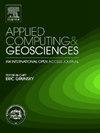Attention and deformable convolution-based dual-task high-precision fault recognition
IF 3.2
Q2 COMPUTER SCIENCE, INTERDISCIPLINARY APPLICATIONS
引用次数: 0
Abstract
Deep learning has been widely applied in fault recognition task. However, current two-dimensional (2D) deep learning-based training methods fail to adequately consider the overall spatial characteristics of faults, resulting in discontinuous fault recognition results and unable to achieve the effect of three-dimensional (3D) deep learning training methods. To address this issue, we propose an attention and deformable convolution-based dual-task high-precision fault recognition method (ADTFM), which introduces a dual-task deep learning network architecture within the 2D training framework, effectively improving the fault recognition accuracy and reliability. ADTFM consists of two tasks (Main task and Auxiliary task) with the same network structure based on the deformable convolution operators and U-Net. The main task uses the Inline direction for training, and uses the deformable convolution operator to capture more accurate fault feature. At the same time, the auxiliary task is trained in the Time-slice direction, and the features generated by auxiliary task direction are transferred to the main task in training process. The two tasks are connected through the attention mechanism, so as to increase the spatial characteristics of faults in 2D training process, and effectively compensate for the spatial limitations of 2D training. By testing the public 3D datasets and the field 3D datasets, and comparing with the current high-precision FaultSeg3D fault recognition method, the results show that our method can improve the accuracy of fault recognition. Moreover, through the quantitative evaluation of computing consumption time and memory, it is shown that the proposed method effectively reduces the computational complexity and decreases the consumption of computational resources, and provide a more efficient solution for fault recognition task.
基于注意力和可变形卷积的双任务高精度故障识别
深度学习在故障识别中得到了广泛的应用。然而,目前基于二维(2D)深度学习的训练方法没有充分考虑故障的整体空间特征,导致故障识别结果不连续,无法达到三维(3D)深度学习训练方法的效果。针对这一问题,我们提出了一种基于注意力和可变形卷积的双任务高精度故障识别方法(ADTFM),该方法在二维训练框架内引入了双任务深度学习网络架构,有效提高了故障识别的准确性和可靠性。ADTFM由两个具有相同网络结构的任务(主任务和辅助任务)组成,它们基于可变形卷积算子和U-Net。主要任务使用内联方向进行训练,并使用可变形卷积算子捕获更准确的故障特征。同时在时间片方向上对辅助任务进行训练,并在训练过程中将辅助任务方向产生的特征传递给主任务。通过注意机制将两个任务连接起来,增加了二维训练过程中故障的空间特征,有效弥补了二维训练的空间局限性。通过对公共三维数据集和现场三维数据集的测试,并与现有的高精度FaultSeg3D故障识别方法进行比较,结果表明本文方法可以提高故障识别的精度。此外,通过对计算消耗时间和内存的定量评价,表明所提方法有效地降低了计算复杂度,减少了计算资源的消耗,为故障识别任务提供了更高效的解决方案。
本文章由计算机程序翻译,如有差异,请以英文原文为准。
求助全文
约1分钟内获得全文
求助全文
来源期刊

Applied Computing and Geosciences
Computer Science-General Computer Science
CiteScore
5.50
自引率
0.00%
发文量
23
审稿时长
5 weeks
 求助内容:
求助内容: 应助结果提醒方式:
应助结果提醒方式:


